
If you’ve found this article, you must be considering (or have already volunteered) to foster a cat. We’re so glad!
You may be a little nervous the first time … or second … or third, for that matter. But it’s an amazing thing you’re doing, and we want to help.
If you’ve already partnered with a rescue organization and been paired with a foster cat, you just need to set up your space and do a little mental preparation.
That’s what we’ll be talking about in this article – ways to prepare your home, set up your foster cat or foster kitten’s space, and set your expectations.
If you’re new to the Foster 101 series, welcome! Depending on where you are in the foster process, you might want to take a look at the earlier articles in the series to find more information on:
- Why fostering is so beneficial (for both cats and humans).
- What you should consider before becoming a foster guardian.
- The process of applying with a rescue and being matched with a foster cat or kitten.
You’re Getting a Foster Cat! Now what?
Things to Know Before Bringing Your Foster Cat Home
By this point, the rescue organization should have given you a pretty clear rundown of what to expect. Just make sure you have these conversations ahead of time, so you can prepare:
- What supplies do you need to provide? A specific type of cat litter, litter box, food, carrier, etc.
- Discuss your foster cat’s disposition and any special needs.
- Does the foster cat have any physical limitations or restrictions? If so, explain your options for setting up the foster space to address them. For example, a senior cat may need a low-sided litter box for easier access. An obese cat may need a slow-feed bowl. As a more extreme example, my current foster cat has pelvic fractures and isn’t allowed to jump. So, I removed the few pieces of furniture I keep in his room.
- Does the foster cat have any physical limitations or restrictions? If so, explain your options for setting up the foster space to address them. For example, a senior cat may need a low-sided litter box for easier access. An obese cat may need a slow-feed bowl. As a more extreme example, my current foster cat has pelvic fractures and isn’t allowed to jump. So, I removed the few pieces of furniture I keep in his room.
- Any habits (good or bad) to work around? Chewing, scratching, climbing, loud meowing, escape artist, messy eater, spraying (that’s a good one to be aware of), etc.
- Any likes or dislikes you can keep in mind? The rescue staff may have some inside scoop to share. For example, does your future foster cat have a favorite type of toy or bed? Do they love having something to climb or dislike getting belly rubs? One of my foster cats loved a little free-standing hammock that he had in the rescue facility, so I put one into his room at my house.
- Ask if they have a social community or private webpage for foster guardians to share their stories with each other and the rescue staff. Many organizations have these, and it can be a great resource as you navigate different foster situations or want to connect with fellow foster guardians.
- What are the policies for handling medical and behavioral problems and emergency situations? Each rescue organization is different. So, knowing this ahead of time makes dealing with these issues much easier.
Find Out About Your Foster Cat’s History
Sometimes, there isn’t much history available for a rescued animal. But I suggest finding out anything you can. This really helps you better understand your foster cat’s behavior. Their past experiences may be influencing their current behavior and can give you insights into where they might need special attention and how you avoid causing them undue stress or anxiety.
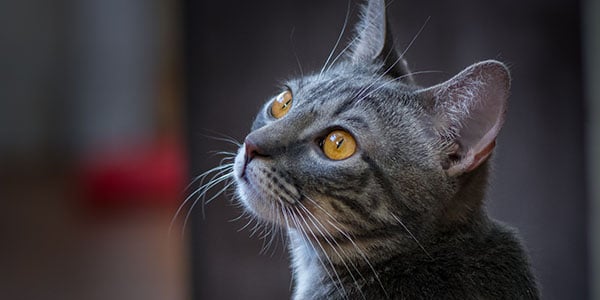
I have a foster cat who is only 12 months old. He spent the last eight months in the rescue facility with medical issues and was on bedrest most of the time. I constantly need to remind myself that most of the things he’s seeing, hearing, smelling, and doing are things that he hasn’t done since he was a three-month-old kitten. Knowing this, it’s easy to understand why he gets overwhelmed so quickly and can act out aggressively.
It’s also believed that he was previously injured by a person, which helps me understand why he overreacts to movements I might make that seem harmless to me. Knowing his history has made me more empathetic to his challenges and has been vital in helping me be a better foster guardian for him.
Setting Up Your Foster Cat's Space
Here, we’ll focus on the basic setup for a cat with no special needs. Keep in mind that you may need to make some adjustments if you’re fostering a cat with medical or behavioral issues.
Why Your Foster Cat Needs a Dedicated Space
A small, quiet area, away from people and other animals, will help your new foster cat (and, frankly, any adopted cat!) feel safe and get comfortable more quickly. The less “newness” they’re forced to interact with in those first few days, the less stress and anxiety they’re likely to feel.
Of course, once they settle in and are ready to venture out, you can let them explore, relocate their essentials (food, litter, etc.) accordingly, and let them share space with other animals (if appropriate and allowed by the rescue organization).
This dedicated safe space also gives you more control over the situation and limits their access to undesirable or unsafe hiding spots. The last thing you want is a scared cat wedged behind your refrigerator or making a run for it when you open the front door.
When There Are No Other Pets at Home
If you don’t have other pets at home, your foster will be lucky to have all of your attention. It’s still helpful to provide that dedicated space initially, though, until you’re familiar with each other. Kitty will need time to acclimate on their terms, so go at their pace.
When You Have A Menagerie of Pets at Home

Having other pets in the household can be wonderful for fostering.
- Your foster may have lived with dogs and cats in a previous home and enjoyed the companionship.
- Seeing your interaction with your resident pets could help build trust and show them what a family is all about.
- It can open up their options for adoption if they’ve been shown to get along with other animals.
- If they’re former strays, didn’t have any siblings, or weren’t able to stay with their mother long enough, they may need help learning how to “be a cat.” With time and patience, they'll learn how to communicate and bond with humans, understand how to play without being too rough, and figure out their way around a house or apartment.
- It’s vital that you introduce everyone in a careful and controlled way. And creating that dedicated space, where your foster cat can feel secure, is even more important. Click here to learn more about how to introduce a new cat to your pets, and check out our Paws & Play podcast episode with Dr. Marci Koski for more tips:
Creating Your Dedicated Foster Cat Space
This is simply a room or enclosed area to keep your foster from roaming your home until they, you, and your other pets are ready. It doesn’t have to be home base for their entire stay. It can be temporary. But it’s a great way to start things off.
Where Should Your Dedicated Foster Cat Space Be?
The easiest option is a spare room, like a guest room or extra bathroom. If you don’t have a spare room, you can use a room with a door, that doesn’t have much traffic throughout the day and keeps other pets out, like a bathroom, master bedroom, or laundry room. (Just make sure you block off hard-to-reach hiding areas, like under the bed or behind the washing machine!) Or, you may have a partially separated area that doesn’t have a door, like a dining room or an office nook, which can work as well, if you create a way to block the entry with a gate.
Cats are obviously more difficult to confine than dogs and other vertically challenged animals in a space without a door. I had one foster cat who was able to scale just about any barrier I created, including a 3½ foot tall, metal crate panel.
If you have a climber, try something like the Songmics Play Pen, which allows you to connect small plastic panels together in a million different ways. In this case, you could construct a divider. Lean it up against the wall and hold it in place with a couple of pieces of furniture, strong tape (just watch out for your paint job), tacks, or whatever else you have around the house that your foster cat won’t be able to knock over.
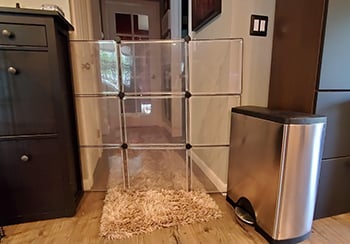
Example using some of the Songmics panels to create a false wall, blocking off a hallway entrance. I used nine panels, but it comes with more, so you can go higher or wider. In this case, I was able to slip one side of the panels behind a piece of furniture and hold the other side against the wall with my garbage can.
If you don’t have a climber, you can try a metal option like this MidWest Cat Playpen, which comes with an optional wire top to limit movement, if you have a foster cat who needs bedrest.
Or you can use these AmazonBasics playpen panels like I do and open them up completely into one long section to block off space. There are multiple playpen heights to choose from — I used the 42-inch size. From there, it’s like a flexible cage-style wall you can set up any number of ways. Just be careful. The panels need to be set up in a sturdy way so they can’t be knocked over.
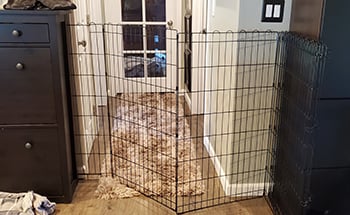 Using the foldable playpen option for the false wall.
Using the foldable playpen option for the false wall.
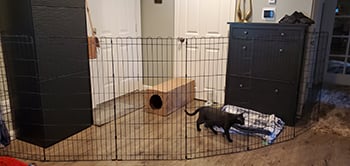
Example of the foldable metal playpen sectioning off a large area in my dining room. Conveniently, I was able to slide both ends of the pen behind sturdy pieces of furniture already in the space.
If none of this is feasible, just work with what you have and do your best to secure the space. Block off any hiding places that could be dangerous or that you wouldn’t be able to access in an emergency (like behind the fridge, open-air vents, packed closets), and try to keep things calm and quiet for a few days.
Give Your Foster Cat Somewhere to Hide
I encourage you to go a step further and create a cozy little hiding spot for your foster cat – simply a small, covered nook where they can tuck in and feel secure. It’s important for any cat in any stage of life, to have a positive place they can escape to when they feel overwhelmed, scared, or just need a quiet moment away from the action. Not only does it help them self-soothe, but it can also improve their confidence.
By nature, cats are both predator and prey. They need and greatly benefit from the ability to feel safe and secure. Not having that escape option to a hiding place can breed insecurity that impacts their behavior on many levels. This is even more poignant with cats coming fresh out of a shelter experience.
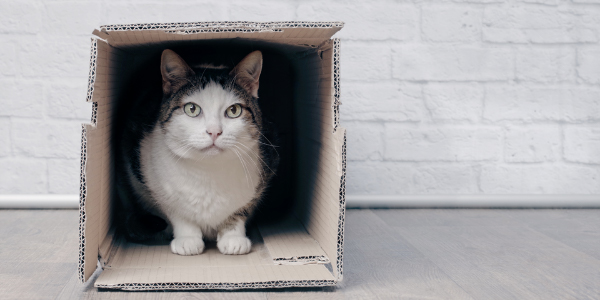 In fact, in a 2017 study looking for ways that shelters can reduce stress for their cats, three different types of environmental enrichment options were provided, including a simple cardboard box. And, you guessed it, the cats preferred the box.
In fact, in a 2017 study looking for ways that shelters can reduce stress for their cats, three different types of environmental enrichment options were provided, including a simple cardboard box. And, you guessed it, the cats preferred the box.
You’ll even find a hiding spot (or safe place) listed as one of the Five Pillars of a Healthy Environment for Cats, as defined by the International Society of Feline Medicine and the American Association of Feline Practitioners. It’s not a matter of “nice to have.” It really is a basic necessity for cats to have this getaway.
You can use any number of things to create a hiding spot:
- Throwing a sheet over a chair or other furniture creates a covered tent-like area.
- Using a small kennel, pop-up enclosure, or even a box, again covered with a sheet or blanket and with a cozy bed inside.
- Construct one using the Songmics Playpen.
- A simple cardboard box with an entryway cut out in the front.
- You can even use their crate or carrier if it's the correct size, and you can make it cozy. Leaving their carrier out and with an open door can encourage your cat to use it as their safe space — which often makes trips to the vet less stressful for your cat.
Using a basic pop-up kennel draped with a blanket, a soft bathmat inside, and food and water just outside. When not in use, these pop-up styles collapse down for easy storage.
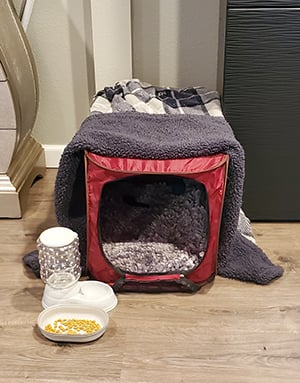
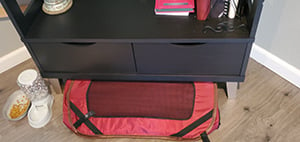
Here, I used the Songmics Playpen panels to create a three-sided enclosure (right side, left side, and top), placed up against the wall, with a bed, food and water inside and draped with a blanket for privacy.
Front view and top view without the blanket.
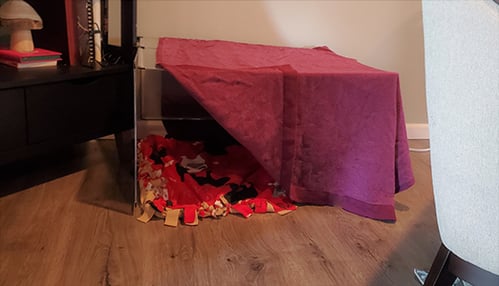
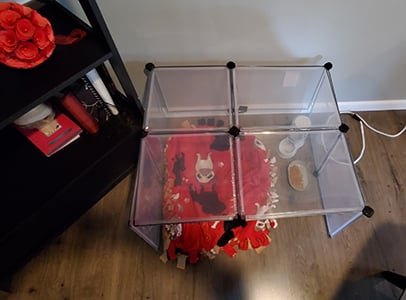
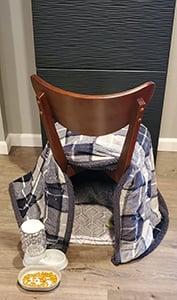 Super easy chair option placed against the wall and covered with a blanket, bed inside, and food and water just outside.
Super easy chair option placed against the wall and covered with a blanket, bed inside, and food and water just outside.
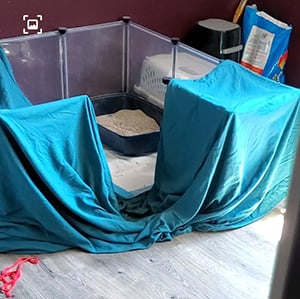
This certainly isn’t the prettiest example, but it got the job done. I used the Songmics panels to create a large, open enclosure to hold all of the essentials.
A draped sheet provided two covered areas, with the bed on one side and food and water on the other side. And the litter box was placed in the corner. It also made a fun play area as my foster rolled around and jumped on the sheet.
The rescue will likely send you home with a few things from your foster cat’s kennel, like a bed, blanket, or toys. These should definitely go in the space to help kitty feel more comfortable.
Important: Avoid washing them right away. It’s the familiar scents that help with the transition.
PRO TIP: You want to make sure food, water and the litter box are close-by (but the food and water bowls should be kept at a distance from the litter box), at least until your foster cat settles in. They should have easy access without having to go too far from their hiding spot. You don’t want them having accidents or holding “it” because they’re not ready to venture out yet.
Of course, having said all this, your foster cat may walk out of their carrier and plop down in the middle of the room, ready for a belly rub, or start exploring right away. But you should still have a hiding spot available for them — especially if you have children or other animals in the home.
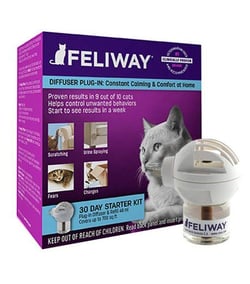 Consider Calming Feline Pheromones
Consider Calming Feline Pheromones
Using calming pheromone diffusers or sprays, such as the Feliway diffuser, can help your foster cat feel less stressed as well. These synthetic versions of cat pheromones mimic the same pheromones cats release and use to mark their territory as "home." Plugging in a pheromone diffuser or lightly spritzing your foster cat's safe space might make the transition to a new environment easier.
The studies surrounding the use of Feliway to reduce stress are quite encouraging. Although your experience may be different, these pheromones can be very helpful, especially with nervous cats. In my experience, I didn't notice a change in my foster cats when using the diffuser, but I currently have the Feliway spray. Results are mixed, but there's no harm in trying, especially with nervous cats, or using the multi-cat diffuser if you have multiple kitties to reduce tension.
Fostering Multiple Cats Simultaneously
If your rescue allows fostering of more than one adult cat at a time, you’ll want to discuss whether the cats have an existing relationship and can be kept in the same space or need to start off in their own separate spaces and go through an introduction process.
Other Important Set-Up Tips
It takes time for any cat to learn the ins and outs of a new home and for you to learn the habits of a new foster cat. You really need to look at your foster space with fresh eyes, like you would with a baby learning to crawl.
You must make sure that your home is “cat-proofed” to keep your foster cat or foster kitten safe. Remember, every cat is unique, and so are their reactions to things like electrical cords, plants, and other potential household hazards. Don’t assume that because your pet cats have never chewed through your phone charger, that your foster cat won’t. In fact, assume they will until they prove otherwise. Better safe than sorry!
Here are some things to think about (and why it’s easier to start your foster out in a dedicated room until you get more familiar with each other):
- Your foster cat might love high places.
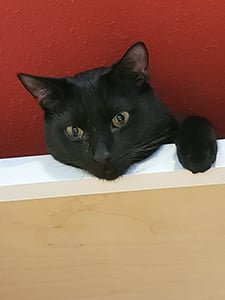
- Take a look around for tall furniture that could tip over, shelves they might be able to jump up onto, and other high perches. Make sure these are secure, so you don’t wake up to crashing sounds and possible medical emergencies. I once had a foster cat who tried to walk across my curtain rods and made a favorite hiding spot in the cabinet above my refrigerator. See the inset picture of my cat Ollie hanging out ABOVE the cabinet, ABOVE the fridge. That’s the red ceiling touching his head.
- Watch out for chewers.
- This was a new one for me, in the cat world. My first foster cat was just fine in his own room. But as soon as I gave him access to the rest of the house, he started chewing on EVERYTHING. Cords (worst nightmare!), shoes, metal cabinet handles, fake plants, furniture, the peddles on my stationary bike. It was dangerous and unexpected. I had to wrap all of my cords in plastic tubing, keep shoes put away, and spend a lot of time watching and teaching him.
PRO TIP: If you have a chewer, a corrugated, flexible conduit like this one from Electriduct is a great option for protecting cords, at a fraction of the price of some of the fancy cord covers on the market. It’s a ridged, plastic tube, split on one side. You can buy it a variety of sizes (width and length) and even paint it out to match walls and floors. There are also clear cord protectors like this one from Critter Cord that are less obvious and discourage chewing.
-
- Look for things like fringe or tassels on curtains and throw pillows, cell phone charger cords, yarn and thread from sewing kits, small choke hazards, etc.
- Look for things like fringe or tassels on curtains and throw pillows, cell phone charger cords, yarn and thread from sewing kits, small choke hazards, etc.
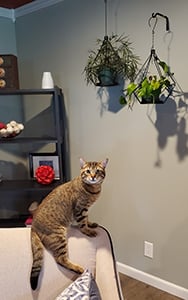 Do a scan for toxic items.
Do a scan for toxic items.
- Houseplants! Many cats love to chomp on anything green and leafy. Common plants like aloe and jade are toxic. Consider putting plants on inaccessible shelves, behind glass in curio-style cabinets, or even hanging them from the wall on brackets (far enough away from jumping-off points so kitty can’t launch across the room and land in your hanging pot. I’ve seen it happen). Avoid lilies in your home! Lilies are extremely toxic to cats. If you want to add some greenery to your home, check out this list of cat-safe plants.
PRO TIP: I can’t hang plants from my ceiling, so I use decorative wall hangers and put the pots in hanging candle holders for a special look.
- Cleaning products: You may keep them in cabinets, maybe under the sink. Well, cats are crafty. Some can open cabinet doors. I’ve had many mornings walking through the house after a good night’s sleep, closing all the doors and drawers my cat had opened overnight.
-
- If you have a cabinet opener, try these strong magnetic door catches. They’re thin, can be attached with screws or double-stick adhesive, and you just need a little oomph to get the cabinet open.
- If you have a cabinet opener, try these strong magnetic door catches. They’re thin, can be attached with screws or double-stick adhesive, and you just need a little oomph to get the cabinet open.
- People food: Simple things you might keep out on the counter, like onions, some artificial sweeteners, grapes, and the caffeine in your morning coffee, can be dangerous for cats to ingest.
- Make sure you don’t have escape routes to the outdoors.
- Open windows: Screens should be secure enough to handle the weight of a cat if they try to jump through the window. This tragedy happens often enough that there's a term for it in the veterinary world: High-Rise Syndrome. If a bird flies by and they jump for it, that screen needs to hold. There are lots of ways to secure window screens, such as screen or grill guards, reinforcing with tape and screws, or screen clips and locks.
- Be careful when opening doors! Talk with your family and guests about making sure they close exterior doors quickly behind them and open with caution when entering. Your family pet may be trustworthy enough not to head out an open door or come when called, but your foster cat won’t be.
And they don’t know your house as “home” yet. If they do get out, they’re in an unfamiliar area and may try and head back to their former home. It’s just bad all around. Watch doors carefully!
- Consider relocating things you love that could be damaged.
- Just for a while, you might want to take your Grandmother’s china or your expensive champagne flutes off the shelf that sits right by the sunniest window in your home. If you have cats, you know they’re famous for knocking things off and over.
Until you know how your foster cat will move around your house, relocate the important stuff. You can also use this Sticky Putty to adhere items to shelves and prevent an adventurous kitty from breaking precious items.
- Just for a while, you might want to take your Grandmother’s china or your expensive champagne flutes off the shelf that sits right by the sunniest window in your home. If you have cats, you know they’re famous for knocking things off and over.
Space SetUp for Foster Kittens
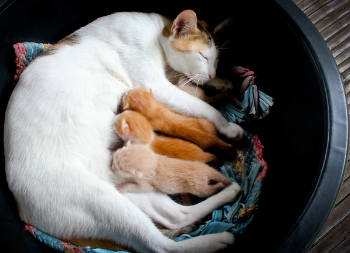
Whether you have a single foster kitten or a whole litter, you’ll need to create a special setup to keep them safe and you sane. And that setup will vary depending on their age. Let’s look at the differences, oldest to youngest.
With kittens, you want a space that can be sanitized/disinfected between litters or after any kitten illnesses. This is especially true if they haven’t been through a two-week quarantine. Many cats spend time in the rescue facility before going to a foster family. This acts as a quarantine period where they can be tested for viruses, and any underlying health issues can be uncovered.
Kittens, however, sometimes go straight to a foster family because they need special care. So, you want to be able to disinfect thoroughly if any contagious illnesses pop up. Hard, non-porous surfaces can be wiped down with Rescue Sanitizing Wipes, an easy-to-use disinfectant and deodorizer used by veterinarians and rescue organizations. Soft things like blankets should be machine washable.
A dilution of bleach (1 part bleach to 32 parts water) is generally recommended to sanitize soft surfaces. However, it is very important that any surfaces sanitized with a bleach solution are thoroughly rinsed with water before any animals are permitted back into the area.
Completely Weaned Kittens (generally eight to ten weeks old)
Kittens start the weaning process around four weeks old. But they aren’t completely weaned (off mother’s milk or formula and eating only solid food) until they’re eight to ten weeks old. This is also the age they can be spayed or neutered, which is often the final step before they go up for adoption. And they tend to be adopted quickly. So, they may only be with you for a few weeks and then on to their forever homes.
Kittens this young are tiny, active, curious, and don’t yet know their limitations. While they may be less timid than adult rescue cats, I wouldn’t let them roam free in the house. They need an enclosed, safe area. Imagine a group of tiny toddlers who can climb the curtains and jump off the counters. If they can get their claws in it, squeeze under it, or fit it in their mouth, they will.
I once lost a kitten for half a day and was in a panic; sure, he’d escaped out the front door. Turns out, he managed to flatten himself, like a rat, and climb under a cabinet that was only about two inches off the floor. He had a nice nap — I had a heart attack. Do yourself a favor and create an enclosed space for your foster kittens to stay when you aren’t watching them.
For kittens, a dedicated room is going to be best. A spare room, laundry room, or bathroom is perfect.
- Address danger zones like full closets, wobbly, or small pieces of furniture that might tip over when climbed on or jumped from, items that can be knocked over, tall furniture they can jump off from and be injured, places they can get stuck, etc.
- Pin curtains a few feet up off the floor so they can’t be climbed or shredded.
- Remove any chewing, choking, or tangling hazards like strings, electrical cords, blinds cords.
If you don’t have a dedicated room, you can create an enclosure using some of the tools we’ve talked about earlier in this article. But you’ll need to watch your kittens closely. (You might even consider using a pet camera. Not only will it give you peace of mind while you’re away, it will provide tons of entertainment for you to watch their crazy antics.
And the kitten’s future adopters might love a little video history of their new baby.) As they develop, so will their ability to get in and out of things. A solution that works at eight weeks may not work at ten weeks.
- The Songmics Playpen can be set up with high sides to keep the foster kittens in.
- A cage-like pen can work as long as the bars are close enough together that the kittens can’t squeeze through, and it has a top, so kittens can’t climb up and over. Make sure they can’t climb too high and jump or fall to the ground.
- A soft-sided pen like the ESK Collection 48” Playpen is a nice option, with its large side and removable top. But being fabric, the better they get at climbing, the more you may find them hanging off the sides and top.
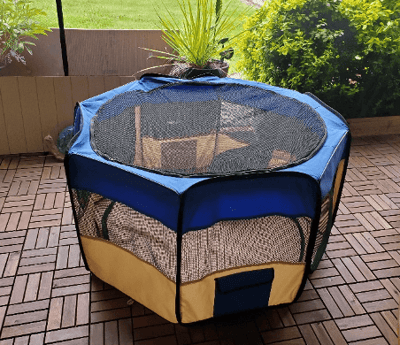
Whatever you use, it should be large enough to hold a small litter box and shallow food and water bowls, along with blankets, age-appropriate toys, and perhaps a small scratching post or cat tree for a safe climbing fix.
Soft-sided pens are also a great way to safely let your cats enjoy the outdoors under strict supervision (you don't want those kitty claws ripping a hole in the side and your foster cat escaping). And they collapse and fold up for easy storage. I use mine on the patio and out in the yard for my adult cats.
Foster Kittens Three to Eight Weeks Old
Kittens of this age are less active but require a deeper level of care, as they’re just going through the weaning process and likely still need some degree of bottle feeding. They’re also just starting to use the litter box.
So, you’ll still need room for a tiny litter box and shallow food and water bowls. But climbing isn’t as big a concern. A soft-sided pen works very well, and a removable top offers easy access for feeding, cleaning, and potty assistance. You’ll also want to include soft bedding and a fluffy stuffed animal or two to give comfort in place of their mother.
While I haven't personally used this product, many colleagues on the Preventive Vet team have used the Snuggle Puppy for their new pups with great success. There is also a Snuggle Kitty option, so you may want to try it out. It mimics the heartbeat and warmth of their mother.
 Newborn Foster Kittens Up to Three Weeks Old
Newborn Foster Kittens Up to Three Weeks Old
These guys are going to be tiny and need very little space. At this age, you’ll be bottle feeding, and they’ll just be starting to crawl. Climbing isn’t an issue.
Believe it or not, one of the best options here is an open-top plastic tub (like a storage container). A kennel or soft carrier that opens from the top works too. You just want that top access to easily see and reach into the enclosure. No litter box, food, or water bowls are needed. And you may need to move the foster kittens throughout the day to keep them close to you. So, these small, easy-to-carry options are ideal. You definitely need soft bedding and a fluffy, stuffed animal for comfort. Depending on the situation, you may also need a heat source.
The Kitten Lady has a terrific video on setting up foster kitten spaces by age.
Foster Cat Expectations
My simple advice on cat fostering expectations is this — try not to have them! Just focus on what you can provide and then go with the flow. You never know what each new foster cat is going to bring. That’s part of the fun!
I had my own foster fantasy. My senior female cat would be the caregiver, and my older male would be the big brother. And the foster cats would settle right in and trust me within minutes.
Sure, that happens. But … it also might not. In reality, two of my cats want nothing to do with my fosters. And my first foster cat stepped out of his carrier, climbed right into my arms for a belly rub, and promptly bit me. (For the record, I adopted him seven days later and absolutely adore him.)

So, it might not go exactly as you imagined. Your foster cat may take time to come out of their shell. Your pet Great Dane might not be the kitty cuddler you were hoping for. But that doesn’t make the experience any less wonderful!
What you’re doing for that little furball is going to change their lives and the lives of the lucky family who adopts them. Just open your mind and your heart, give what you can, accept what they offer, and enjoy the cat fostering experience, whatever it may be.



